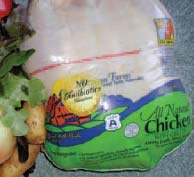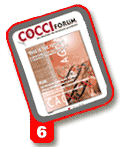COCCI News
Product updates and industry trends
 Mathis: 'Vaccination is
a viable alternative.'
|
Which coccidiosis-control methods are best to use in light
of the economic constraints facing poultry producers?
Greg Mathis, president of Southern Poultry Research,
addressed this question in an article published last November
in World Poultry USA.
The advantages of anticoccidials include a broad selection
of products, ease of administration and long track record,
Mathis says. The down side includes varied effectiveness, the
potential of toxicity and, of course, resistance development.
The relatively low cost of some anticoccidials such as salinomycin
has increased their use, contributing to resistance
and use of lower anticoccidial levels. Producers need to
weigh any savings against the risk of reduced performance,
Mathis says.
Vaccination is the other primary method of coccidiosis control
and its use has soared in part due to better methods of
application, anticoccidial resistance and the demand for drugfree
birds. Coccidiosis vaccines are easy to use, Mathis
reports.
In addition, studies have shown that Coccivac-B can
change a coccidial population from resistant to sensitive;
Immucox may have this trait though "no information supporting
this is available," he says.
Vaccination disadvantages cited by Mathis are the "comparable
cost of vaccines and anticoccidials, and the fact that live
organisms must be handled carefully." Care must be taken to
ensure that nonmedicated feed is used during grow-out in
vaccinated birds, but this kind of concern is diminishing as
experience with the vaccines grows,
he says.
A coccidiosis vaccination program
can equal an ionophore program
and possibly yield superior performance
if a late challenge occurs.
"Thus, vaccination is a viable alternative
to anticoccidials in broilers,"
Mathis says. Vaccination offers the
bonus of a drug-free bird if growthenhancing
antibiotics aren't used,
and will alter coccidial sensitivity
patterns, restoring sensitivity to anticoccidials.
Mathis also provides seasonal recommendations for maximizing
coccidiosis control. He advises producers to monitor
for resistance, especially when chemicals are used. Although
"straight" programs seem cost-effective, there's a greater risk
for resistance development. Ionophore-to-ionophore shuttle
programs should be avoided and ionophores should be
selected based not just on price alone, but on species efficacy.
If a straight program must be used, Mathis recommends that
coccidiosis vaccination be part of the yearly program to shift
the resistance pattern to sensitive.
For a limited time, reprints of this educational article are
available from Schering-Plough Animal Health representatives
or send your name and address to phyllis.middleton@
spcorp.com. Fax: 908-629-3206. Ask for SPAH-PBU-252.
Processed vs. Natural vs. Organic: The Final Word
As reported in the last issue of CocciForum ("Natural
Tendencies" CocciForum No. 5), mainstream poultry producers
are increasingly turning to vaccines to produce what consumers
consider more "natural" poultry products. Playing by the rules
The bottom line: The same rules for
drugs and vaccines that apply to all
other chicken products apply to socalled
"natural" chicken as well:
ionophoric anticoccidials (monensin,
lasalocid, salinomycin) are allowed, as are
growth promoters (bacitracin, virginiamycin,
and bambermycin). Just the facts
But the FSIS says that even though many consumers consider
such added claims to be an integral part of the "natural" labeling
requirements, that's not the case. Again, "natural" refers
only to what happens to the product during processing, in
other words, after slaughter, not before. Four organic categories
And what about "organic" foods?
There are more recent changes on
that front. The USDA, just this past October as
the last issue of CocciForum was going to press, published a
new set of national standards for foods labeled "organic." The
USDA set up four new categories: Leaning on vaccination
One way that growers are managing to cut down on the use
of drugs in their birds "and thus attract consumers seeking
chicken with less additives "is to lean more heavily on their
use of vaccination, especially vaccination against coccidiosis. |
Source: CocciForum Issue No.6, Schering-Plough Animal Health.








